Super capacitor | Chem. Eng. J. | based on high concentration MXene precipitation of high energy density area of 3 d printing quasi solid super capacitor
QQ Academic Group: 1092348845
Detailed
MXene is a two-dimensional star material that is even more popular than graphene. As an advanced manufacturer of MXene, Beike Nano has launched special offer activities, where mxene and other materials are 10% off. At the same time, Beike Nano has launched new mesoporous material products with more preferential prices.
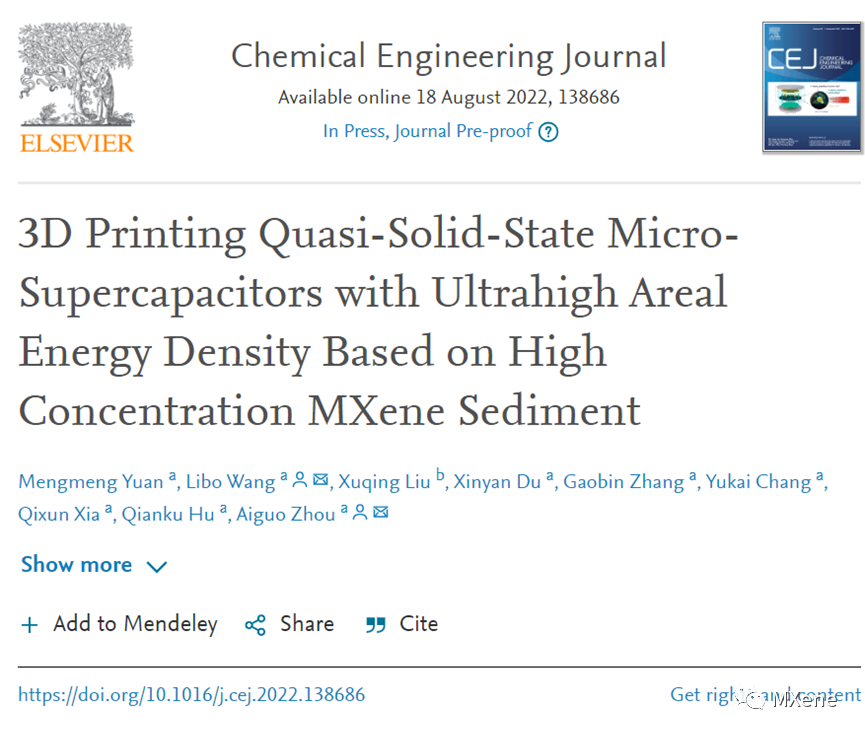
The quick reference
S recently, Professor Wang Libo and Professor Zhou Aiguo from Henan Polytechnic University published a paper titled "3D Printing Quasi Solid-State Micro-Supercapacitors with" in the international Journal Chemical Engineering Ultrahigh Areal Energy Density Based on High Concentration MXene Sediment ". At present, monolayer MXene is mainly used in the preparation of solid-state micro supercapacitors, while multilayer MXene and unetched MAX phase precipitates are often discarded, which not only wastes a large amount of raw materials, but also increases the manufacturing cost, which does not meet the requirements of large-scale industrial production. In addition, monolayer MXene has a low dispersion concentration and needs to be concentrated before printing, which is a relatively complex process. In this paper, a supercapacitor prepared by 3D printing based on high-concentration, additive-free MXene sediments is reported, which has good cycle stability and high area capacitance/energy density. In addition, it shows good electrochemical performance at different bending angles. Therefore, MXene precipitation-based inks have an important application prospect in the next generation of 3D printing customized high-capacity, energy-density devices.
Abstract, The. research
■ 3D printing of highly efficient energy storage electrodes offers new possibilities for applications in portable and micro devices. This paper reports the preparation of quasi-solid symmetric miniature supercapacitors based on additive free MXene precipitates by 3D printing technology. By adjusting the concentration of the MXene sediment to achieve appropriate viscoelasticity, micro-supercapacitors with different structures were printed on the substrate at room temperature using direct printing technology. It is found that the 3D-printed mini supercapacitor has good charge storage capacity. At 2mV s-1, the area capacitance is 2.337 F cm-2, the energy density is 207.81μWh cm-2, the power density is 3.74 mW cm-2, and the capacitance retention rate is 93.1% after 10,000 cycles. Miniature supercapacitors fabricated using waste-free MXene precipitate ink combined with 3D printing technology offer an option for manufacturing the next generation of portable and wearable electronic devices.
1. 1. the. research points
■ High concentration MXene precipitation ink with adjustable rheological properties and suitable viscoelasticity for MSCs production was obtained by simple centrifugation and control of DMSO intercalated MXene precipitation concentration after ultrasonic centrifugation. The MXene precipitate with low peeling degree is further peeled off under the action of shear force during 3D printing. The composite porous structure formed by d-Ti3C2Tx and m-Ti3C2Tx is conducive to charge transport and improves electrochemical performance and efficiency.

Figure 1. Structural characterization of Ti3C2Tx MXene sediments. (a) XRD patterns of Ti3AlC2, etched Ti3C2Tx, stripped Ti3C2Tx and Ti3C2Tx deposits. (b) magnification of XRD in the range of 5°-10°. (c) XRD and (d) Raman patterns of 3DP-MSCs and MXene sediments. (e) Plot of viscosity versus shear rate of MXene sediment ink. (f) Plot of storage modulus and loss modulus as a function of strain. (g) XPS spectra of MXene sediments; (h) C 1 s; And (i) Ti 2p.
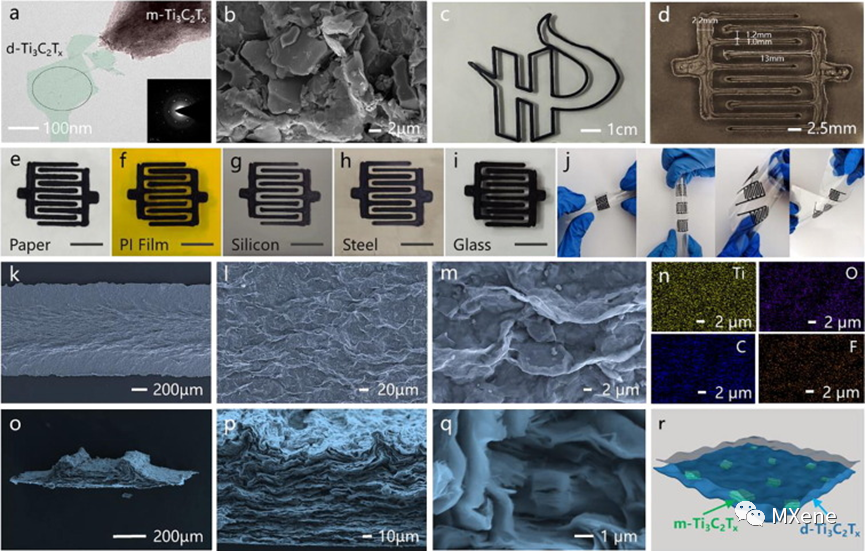
Figure 2. Print patterns and structural characterization of Ti3C2Tx MXene sediments. (a) TEM and SAED images of MXene deposited ink. (b) SEM images of MXene sediments, showing the presence of multiple layers of MXene. (c) A 3D-printed school logo. (d) Optical photograph of the electrode. MXene sediment inks are printed on different substrates such as (e) paper, (f) PI film, (g) silicon wafers, (h) stainless steel plates, and (i) glass. The scale line in Figs. 3e to i is 1 cm. (j) The printed device exhibits good adhesion to the substrate during repeated bending and twisting. (k,l,m,o,p,q) SEM images of the surface and cross section of the electrode prepared at different magnification. (n) EDS analysis of electrode surface, corresponding to the corresponding element diagrams of Ti, O, C and F. (r) Schematic diagram of the microstructure of the electrode.
1. the main points of research, 2
■ Forkfinger electrodes were fabricated by 3D printing using the MXene precipitated ink, and quasi-solid supercapacitors were fabricated by packaging PVA/H2SO4 gel as electrolyte. The electrochemical characterization results show that MSCs have good charge storage capacity and stability, which is higher than that of previously reported supercapacitors. At 2mV s-1, the area capacitance is 2.337 F cm-2, the energy density is 207.81μWh cm-2, and the power density is 3.74 mW cm-2.
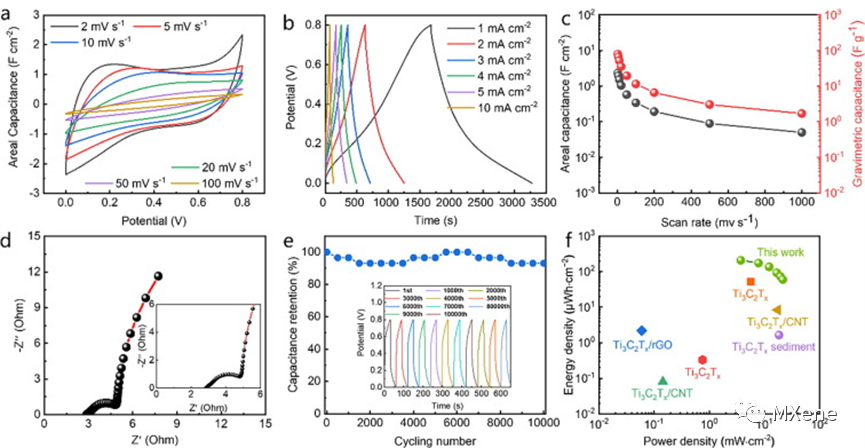
FIG. 3. Electrochemical performance of a miniature supercapacitor 3D printed on Ti3C2Tx MXene sediment. (a) CV curves collected at different scan rates of 2-100 mV s-1. (b) GCD curves collected at different current densities of 1-10 mA cm-2. (c) Changes in area capacitance and mass capacitance at different scanning rates. (d) Fitted Nyquist chart. (e) At a current density of 10 mA cm-2, the long-term stability of MSCs was tested for 10,000 cycles with a capacity retention rate of 93.1%. (f) Ragone diagram comparing the 3D-printed MSCs in this study with other reported MSCs.
3, the. research points
■ MXene sediment inks can be printed on a variety of substrates, including flexible polymers, glass, paper, stainless steel, etc. MXene supercapacitors printed on PET substrates have good capacity retention at different angles. The 3D printed devices can also be directly fabricated into series and parallel integrated devices to achieve high capacity or high voltage output.
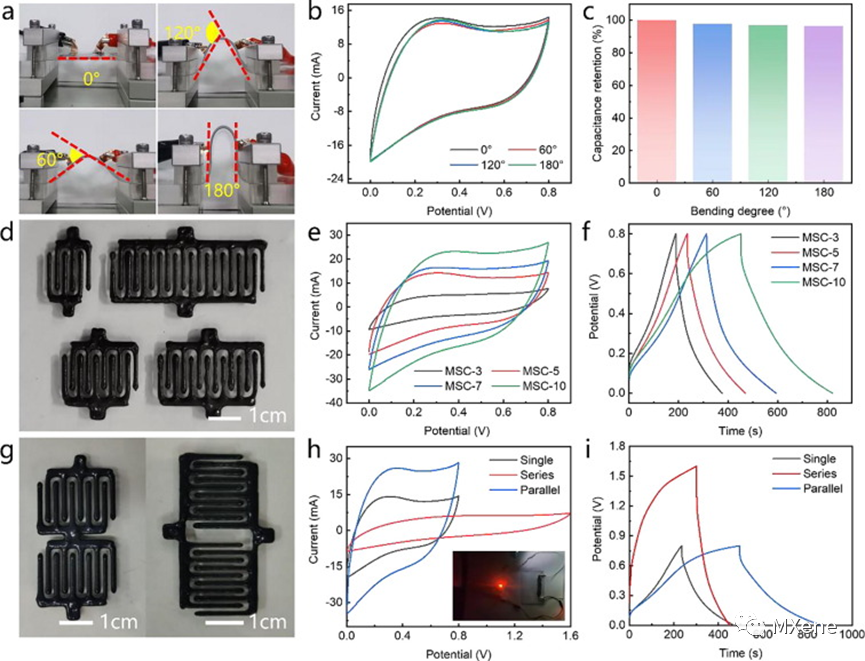
Figure 4. Electrochemical performance of the 3D printed micro supercapacitor based on Ti3C2Tx MXene sediment at different angles, different fork indices and series and parallel connections. (a) The bending of MSCs at different angles shows that MSCs have great mechanical flexibility. (b) CV curves of different bending angles (0°, 60°, 120°, 180°). (c) Capacitance retention of MSCs at different bending angles. (d) Photograph of the MSC-n. (e, f) CV curves and GCD curves of different MSC-n (where n is the number of printed channels) (MSC-3, MSC-5, MSC-7, MSC-10). (g) Photographs of series and parallel MSCs. (h, i) CV curves and GCD curves of MSCs in series and parallel, and test their electrochemical performance at higher voltages and currents. Series mini-supercapacitors can light small bulbs.
1. the study, summary, the
■ An additive free MXene precipitate ink for 3D printing has been prepared by a simple method. The ink has excellent rheological and printing properties and can be used to print devices on different substrates. By adjusting the ink concentration, changing the number of MSC-n channels and the series-parallel connection mode, miniature supercapacitors with excellent area capacitance, high energy/power density and large operating voltage window can be manufactured. The 3D-printed miniature supercapacitor piece displays ultra-high area capacitance up to 2337 mF cm-2 with long-term cycle stability of 10,000 cycles. Compared with stripping monolayer MXene, the preparation process of multilayer MXene is simpler, with lower cost and higher benefit. Thus, this additive free, low-cost, waste-free MXene precipitated ink can be used in electromagnetic shielding, sensors, electronics, and biomedicine, meeting the needs of the next generation of miniaturized electronic devices.
Link to article (read full article)
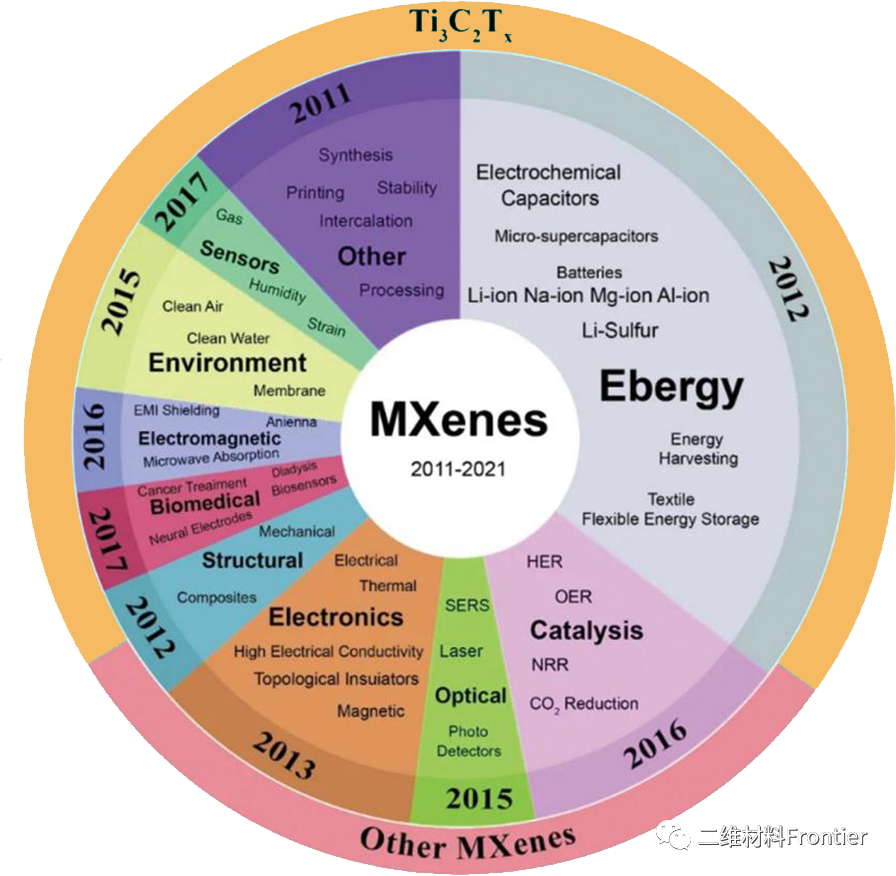


The quick reference
S recently, Professor Wang Libo and Professor Zhou Aiguo from Henan Polytechnic University published a paper titled "3D Printing Quasi Solid-State Micro-Supercapacitors with" in the international Journal Chemical Engineering Ultrahigh Areal Energy Density Based on High Concentration MXene Sediment ". At present, monolayer MXene is mainly used in the preparation of solid-state micro supercapacitors, while multilayer MXene and unetched MAX phase precipitates are often discarded, which not only wastes a large amount of raw materials, but also increases the manufacturing cost, which does not meet the requirements of large-scale industrial production. In addition, monolayer MXene has a low dispersion concentration and needs to be concentrated before printing, which is a relatively complex process. In this paper, a supercapacitor prepared by 3D printing based on high-concentration, additive-free MXene sediments is reported, which has good cycle stability and high area capacitance/energy density. In addition, it shows good electrochemical performance at different bending angles. Therefore, MXene precipitation-based inks have an important application prospect in the next generation of 3D printing customized high-capacity, energy-density devices.
Abstract, The. research
■ 3D printing of highly efficient energy storage electrodes offers new possibilities for applications in portable and micro devices. This paper reports the preparation of quasi-solid symmetric miniature supercapacitors based on additive free MXene precipitates by 3D printing technology. By adjusting the concentration of the MXene sediment to achieve appropriate viscoelasticity, micro-supercapacitors with different structures were printed on the substrate at room temperature using direct printing technology. It is found that the 3D-printed mini supercapacitor has good charge storage capacity. At 2mV s-1, the area capacitance is 2.337 F cm-2, the energy density is 207.81μWh cm-2, the power density is 3.74 mW cm-2, and the capacitance retention rate is 93.1% after 10,000 cycles. Miniature supercapacitors fabricated using waste-free MXene precipitate ink combined with 3D printing technology offer an option for manufacturing the next generation of portable and wearable electronic devices.
1. 1. the. research points
■ High concentration MXene precipitation ink with adjustable rheological properties and suitable viscoelasticity for MSCs production was obtained by simple centrifugation and control of DMSO intercalated MXene precipitation concentration after ultrasonic centrifugation. The MXene precipitate with low peeling degree is further peeled off under the action of shear force during 3D printing. The composite porous structure formed by d-Ti3C2Tx and m-Ti3C2Tx is conducive to charge transport and improves electrochemical performance and efficiency.

Figure 1. Structural characterization of Ti3C2Tx MXene sediments. (a) XRD patterns of Ti3AlC2, etched Ti3C2Tx, stripped Ti3C2Tx and Ti3C2Tx deposits. (b) magnification of XRD in the range of 5°-10°. (c) XRD and (d) Raman patterns of 3DP-MSCs and MXene sediments. (e) Plot of viscosity versus shear rate of MXene sediment ink. (f) Plot of storage modulus and loss modulus as a function of strain. (g) XPS spectra of MXene sediments; (h) C 1 s; And (i) Ti 2p.

Figure 2. Print patterns and structural characterization of Ti3C2Tx MXene sediments. (a) TEM and SAED images of MXene deposited ink. (b) SEM images of MXene sediments, showing the presence of multiple layers of MXene. (c) A 3D-printed school logo. (d) Optical photograph of the electrode. MXene sediment inks are printed on different substrates such as (e) paper, (f) PI film, (g) silicon wafers, (h) stainless steel plates, and (i) glass. The scale line in Figs. 3e to i is 1 cm. (j) The printed device exhibits good adhesion to the substrate during repeated bending and twisting. (k,l,m,o,p,q) SEM images of the surface and cross section of the electrode prepared at different magnification. (n) EDS analysis of electrode surface, corresponding to the corresponding element diagrams of Ti, O, C and F. (r) Schematic diagram of the microstructure of the electrode.
1. the main points of research, 2
■ Forkfinger electrodes were fabricated by 3D printing using the MXene precipitated ink, and quasi-solid supercapacitors were fabricated by packaging PVA/H2SO4 gel as electrolyte. The electrochemical characterization results show that MSCs have good charge storage capacity and stability, which is higher than that of previously reported supercapacitors. At 2mV s-1, the area capacitance is 2.337 F cm-2, the energy density is 207.81μWh cm-2, and the power density is 3.74 mW cm-2.

FIG. 3. Electrochemical performance of a miniature supercapacitor 3D printed on Ti3C2Tx MXene sediment. (a) CV curves collected at different scan rates of 2-100 mV s-1. (b) GCD curves collected at different current densities of 1-10 mA cm-2. (c) Changes in area capacitance and mass capacitance at different scanning rates. (d) Fitted Nyquist chart. (e) At a current density of 10 mA cm-2, the long-term stability of MSCs was tested for 10,000 cycles with a capacity retention rate of 93.1%. (f) Ragone diagram comparing the 3D-printed MSCs in this study with other reported MSCs.
3, the. research points
■ MXene sediment inks can be printed on a variety of substrates, including flexible polymers, glass, paper, stainless steel, etc. MXene supercapacitors printed on PET substrates have good capacity retention at different angles. The 3D printed devices can also be directly fabricated into series and parallel integrated devices to achieve high capacity or high voltage output.

Figure 4. Electrochemical performance of the 3D printed micro supercapacitor based on Ti3C2Tx MXene sediment at different angles, different fork indices and series and parallel connections. (a) The bending of MSCs at different angles shows that MSCs have great mechanical flexibility. (b) CV curves of different bending angles (0°, 60°, 120°, 180°). (c) Capacitance retention of MSCs at different bending angles. (d) Photograph of the MSC-n. (e, f) CV curves and GCD curves of different MSC-n (where n is the number of printed channels) (MSC-3, MSC-5, MSC-7, MSC-10). (g) Photographs of series and parallel MSCs. (h, i) CV curves and GCD curves of MSCs in series and parallel, and test their electrochemical performance at higher voltages and currents. Series mini-supercapacitors can light small bulbs.
1. the study, summary, the
■ An additive free MXene precipitate ink for 3D printing has been prepared by a simple method. The ink has excellent rheological and printing properties and can be used to print devices on different substrates. By adjusting the ink concentration, changing the number of MSC-n channels and the series-parallel connection mode, miniature supercapacitors with excellent area capacitance, high energy/power density and large operating voltage window can be manufactured. The 3D-printed miniature supercapacitor piece displays ultra-high area capacitance up to 2337 mF cm-2 with long-term cycle stability of 10,000 cycles. Compared with stripping monolayer MXene, the preparation process of multilayer MXene is simpler, with lower cost and higher benefit. Thus, this additive free, low-cost, waste-free MXene precipitated ink can be used in electromagnetic shielding, sensors, electronics, and biomedicine, meeting the needs of the next generation of miniaturized electronic devices.
Link to article (read full article)


- Previous: MXene Materials Joint
- Next: MXene breakthrough: Na


 mxene academic
mxene academic
